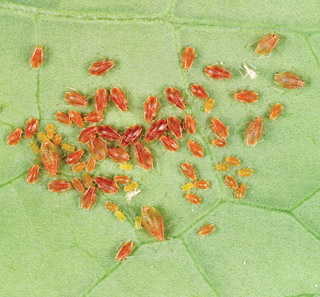Climate Change Scenarios and Issues for Crops in Scotland
Published on 27 January 2009 in Climate, water and energy
Introduction
Climate change is widely recognised as the most serious environmental threat facing the world today and is becoming central to policy-making and land-use decision-making. The climate change predictions for Scotland include increased temperatures, seasonal changes in precipitation patterns resulting in both drought and flooding/waterlogging, longer growing seasons and more extreme weather events. The Scottish Government has set ambitious targets in its Climate Change Strategy, announcing a proposed target for reduction of GHG emissions of 80% by 2050. Much of the science research funded by the Scottish Government in their Sustainable Agriculture - Plants programme is about providing the tools and resources for both mitigating climate change and adapting to its consequences. In many respects climate change-related research is that which we have been carrying out successfully for many years which has advanced the utility of our crops. However, recognition of the global nature of the change, its man-made cause and the enormous scale and seriousness of the consequences has re-emphasised the importance of developing sustainable and resilient solutions to the environmental changes we are likely to face.
Key Points
Our climate in Scotland has been changing in line with the overall trend with a mean temperature rise over the last 40 years of about 1.2°C. The long-term effects on our soils as a carbon sink and resource for crop growth are not known. The consequences of climate change, particularly milder winters, are already being seen in our crops, for example blackurrant crops where lack of winter chill results in asynchronous development, more specifically uneven budbreak and subsequently uneven ripening. Pests and pathogens are organisms which are specifically adapted to exploit resources not adequately protected by plant defence mechanisms. Climate change will open new opportunities for these organisms. Climate change has implications for yield and quality too, often likely to be negatively affected either directly, or from increased or changed pest and pathogen attacks. Moreover effects are likely to be less predictable as a consequence of changed precipitation patterns and more extreme weather events. Furthermore, effects of climate change on one organism may have unpredictable consequences for secondary organisms which feed off them, and the further levels of organisms which feed off these.
Research Undertaken
Climate measurements have been made on the main Mylnefield SCRI site continuously since 1959, and whilst much of the data collected is standard, it includes measurements of soil temperature at 10, 20, 30, 50 and 100cm depths and clearly demonstrated that even the subsoil is warming. This may have profound implications for the biological processes involved in carbon cycling in soils and therefore the long-term health of our crop land. We are also studying carbon additions to our soil using farm yard manure and municipal compost, the latter offering a potentially important means of mitigation whilst improving our crop soil.
.jpg)
.jpg)
.jpg)
Plants showing climate change-induced development problems now: blackcurrants with uneven bud-break.
The populations of the peach potato aphid (Mysus persicae), the potato late blight pathogen (Phytophthora infestans) and other pathogens are being monitored in detail both quantitatively and by studying the genetic structure of their populations to determine how much climate is driving changes, and how much is driven by factors such as varieties, agronomic practice and agrochemical control measures. These threats feature strongly in an assessment of the likely changes in pest and pathogen threats, particularly the possible effects of climate change on aphid populations transmitting viruses to potatoes as the virus-free status of the Scottish seed potato industry is crucial and could be threatened. Solutions via both breeding for resistance and development of crop protection methods are central to our research and integrating these with continued improvements in quality and yield in new cultivars is pursued through networks with plant breeders.

The composition of aphid populations on potato crops may reflect changes in climate and this in turn will alter virus levels.
An example of the effects of climate change on complex interactions between plants, pests, pathogens and other organisms such as nitrogen fixing bacteria in root nodules is shown in work carried out in our elevated CO2 chambers on a legume and insect interaction. Under 700 µl l-1 CO2 the number of root nodules increases, but so does the number of Sitona lepidus larvae which target root nodules resulting in reduced root nitrogen per unit root dry mass.

A climate chamber at SCRI which allows control of CO2 levels and soil temperature profiles independently of the air temperature.
Policy Implications
Cultivation and soil amendment strategies which encourage accumulation or minimise loss of carbon from soils should be developed and promoted. We must invest in developing germplasm and research and development resources which accelerate development of resilient crops against pest and pathogen threats and climate stresses whilst continuing to improve both yield and quality. Improved resource use efficiency should be a priority within this, particularly for water and nutrients. Continuous monitoring, analysis and modelling of the changes in pest and pathogen populations will be essential for understanding and predicting problems and targeting breeding and crop protection solutions. Acquiring facilities for testing such germplasm under climate change scenarios and subject to pest and pathogen attack will be necessary.
The effects of climate change are on all land use issues, not just crops highlighted above, and just as climate is a complex system, so must our response be. Research will address not only these and other biological interactions, but also the socio-economic implications of adaptation and mitigation actions.
Author
Adrian C Newton, Peter J Gregory Adrian.Newton@scri.ac.uk







